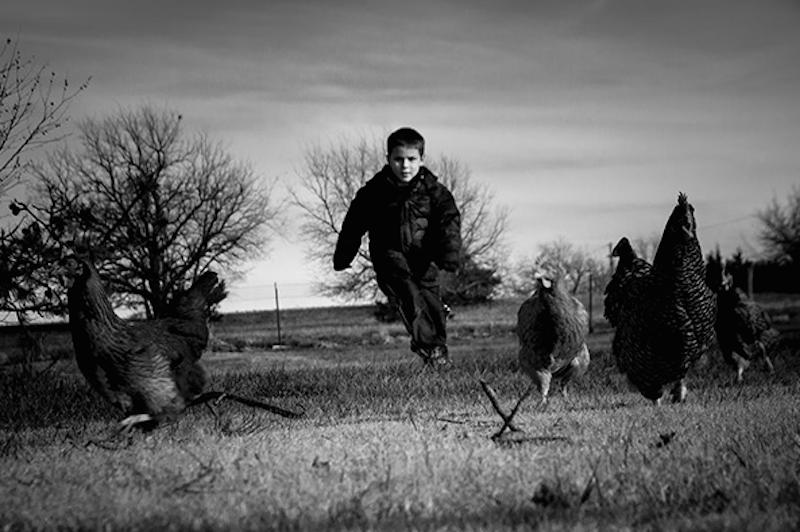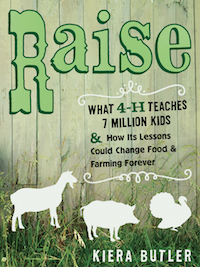
In places where people have unbridled access to boxed, packaged, and processed foods, we tend to lose sight of what we’re eating, let alone where it comes from. Journalist Kiera Butler is committed to sustainable eating, and when she discovered the 4-H program, she realized millions of children worldwide may know more about sustainable food practices than many Western adults. The h’s in 4-H stand for head, heart, hands, and health). She argues that we’re at a critical juncture in agriculture right now: in limbo between large-scale monocropping and a more environmentally friendly local food movement. For her recent book Raise, Butler explored the program in California and traveled to Ghana to see how it functions there. With its massive member base of children, she points out, 4-H has a unique opportunity to shift the direction agriculture is taking.
SCOPE: So what is 4-H exactly?
Kiera Butler: It started as an agricultural organization for kids. It was a project of the land grant universities in the United States more than one hundred years ago. This was [around] the dawn of the Industrial Revolution, and new kinds of farming techniques were being discovered. Farmers had been doing things the same way for generations, and they were a little bit wary of the new methods that the universities were peddling — the machinery, the tractors. The university people had the bright idea of making these agricultural clubs for kids and teaching the kids the new methods. Through the kids they hoped to reach the parents, and it really worked. It’s changed a lot since then. Today, it has seven million members in most countries in the world, and it’s really about more than just agriculture. Clubs in cities do everything from video production to coding to robotics to art projects. You name it and there’s a 4-H program for it.
What led you t o write about it?
o write about it?
My friends and I were enchanted by the idea of urban farming. We did pretty well with the chickens we raised, so we decided to get turkeys. But as we discovered, turkeys required a whole lot of protein, and we had absolutely no idea how to provide that for them, let alone getting them enough exercise and taking care of them in the proper way. So we were combing the internet for tips on how to raise your urban turkeys and feeding them canned tuna and stuff. And then I happened to go to the fair where I saw these five-year-olds with these beautiful turkeys that they had raised by hand. They had made posters about exactly how much protein turkeys need, and they were wearing white pressed uniforms, and they seemed to have leapt into this whole world of agricultural knowledge that my friends and I, who were in our late twenties and early thirties, couldn’t seem to find on our own. I stuck around and saw little tiny kids leading around these hulking steers. A week or two after that, I discovered that there was a 4-H club right in Oakland [California]. That was surprising to me because I had sort of assumed that 4-H was something that people did way out in the country. Not only that, but I found out that the 4-H club in Oakland was actually raising goats. I [connected] with a few of the club leaders, and from there it just sort of morphed into a book pretty quickly.
I grew up in a somewhat rural area, and I’m into the local food movement. But I’ve never heard of 4-H! It seems so cultish. Why do you think it’s so underground?
[Laughs] I think it kind of depends where you are. 4-H runs all kinds of programs: They run the traditional programs where you go to a meeting every month and participate in a project, like a livestock project. And then they also run after school programs and camps. I guess I could see where the club ones would seem a little more cultish. It’s certainly a lifestyle, especially in agricultural areas. People get really into 4-H. They spend hours and hours every day raising their animals, and everybody looks forward to the fair as the pinnacle of the year. You have your fair friends and you spend all day with them. It’s kind of the way that some people feel about summer camp. It’s kind of an identity, you know?
[pullquote]It’s not that uncommon that you would have a public-private partnership, but what concerned me was that the agendas of the sponsors made it into the programming[/pullquote]
What are some of the ethical concerns you had with 4-H?
So 4-H has a foundation, the National 4-H Council. It’s kind of a fringe program because it’s part of the USDA [Department of Agriculture] but it’s [4-H’s] fundraising arm. Many of the sponsors are agribusiness companies: DuPont, Monsanto, Kraft Foods, and Lockheed Martin have sponsored. It’s not that uncommon that you would have a public-private partnership, but what concerned me was that the agendas of the sponsors made it into the programming. I found a 4-H curriculum about biotechnology, and it was sponsored and produced by DuPont. The kids are instructed to make themselves a glass of Nesquik. They stir up the milk and see how the powder dissolves, and from this they’re meant to learn about the properties of soy lecithin. Well, it turns out DuPont is the primary producer of soy lecithin. So you can see how, in this lesson, it would behoove them to have kids have this fun experience with their product.
What about the way their clubs are run in parts of Africa?
They run a program in Ghana that’s also sponsored by DuPont. It provides hybrid maize seeds to clubs in rural agricultural communities. These seeds have some really good qualities. They are resistant to drought, they’re very high-yielding — much more high-yielding than what people in Ghana normally will use for maize. So the idea is that kids will plant these seeds in their club spots and the parents will see how well they do, and they will want to buy them for themselves. It’s very similar to the model that 4-H clubs used at the turn of the last century in the United States. The problem is the seed is really expensive—about ten times the cost of the seed that they’re [currently] using in Ghana. It requires a lot of other chemical interests, like fertilizer and herbicide. The people are poor, and there’s no way for them to afford this seed and the chemical inputs that they need to make it work. If DuPont sets up a dynamic where people in Ghana are dependant, season after season, on an American agribusiness company in order to maintain their livelihood, that’s troubling.
So with that in mind, what kind of values does 4-H teach kids in the end? What potential does the program have for sustainable farming?
Despite the fact that I don’t think the agribusiness sponsors are a particularly good influence on kids, the kids I saw in California had incredible experiences with 4-H. 4-H programs very much reflect the communities that they’re in, and here in Northern California, you have a lot of people who are really into sustainable food. They’re thinking about how to make sure that agriculture continues to work in the future, and how we can support the soil rather than extract from the soil. [Children I met] learned about what it is to feel connected to an animal, how to take care of the animal in a humane way. I think 4-H, with its seven million members, has a lot of power. There are a lot of bright spots in the program where you see kids learning to think critically about farming and where their food comes from. I want to make 4-H aware that they have this incredible opportunity with kids, and I hope that they take it.
This interview has been condensed and edited.

